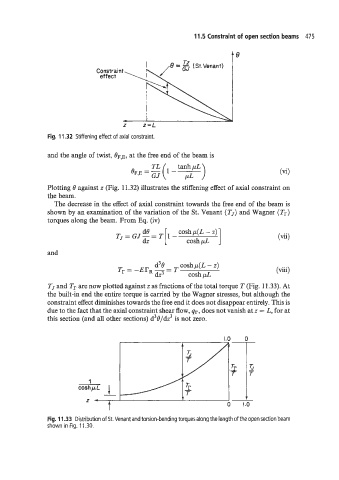Page 494 - Aircraft Stuctures for Engineering Student
P. 494
11.5 Constraint of open section beams 475
z z=L
Fig. 11.32 Stiffening effect of axial constraint.
and the angle of twist, at the free end of the beam is
TL
ei=:E==(1-7) pL
tanh
Plotting 6 against z (Fig. 1 1.32) illustrates the stiffening effect of axial constraint on
the beam.
The decrease in the effect of axial constraint towards the free end of the beam is
shown by an examination of the variation of the St. Venant ( TJ) and Wagner (Tr)
torques along the beam. From Eq. (iv)
(vii)
and
d38 coshp(L - z)
Tr = -ErR - T (viii)
=
dz3 cosh pL
Tj and Tr are now plotted against z as fractions of the total torque T (Fig. 11.33). At
the built-in end the entire torque is carried by the Wagner stresses, but although the
constraint effect diminishes towards the free end it does not disappear entirely. This is
due to the fact that the axial constraint shear flow, qr, does not vanish at z = L, for at
this section (and all other sections) d38/dz3 is not zero.
Fig. 11.33 Distribution of St. Venant and torsion-bending torques along the length of the open section beam
shown in Fig. 11.30.

